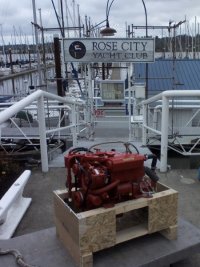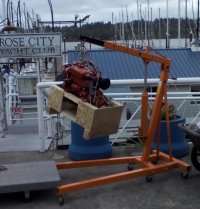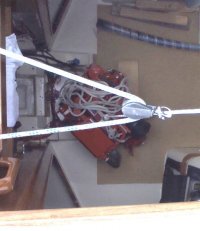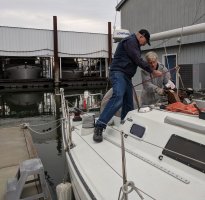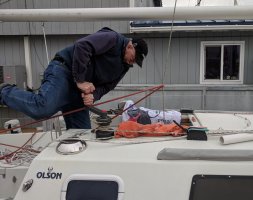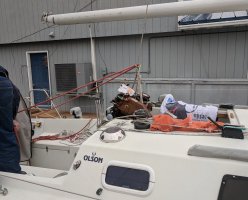This February we started the process of changing to a new diesel engine.
While local trusted mechanics agree that most any middle-age diesel can be maintained or rebuilt to run indefinitely, there are practical reasons for replacement.
Aside: a friend had to trouble shoot a low oil pressure pump on his late-70’s Yanmar YSM-12, and it took some real sleuthing to find parts. He succeeded, and the engine runs well and remains reliable. Still, as these power plants get older parts become increasingly rare.
With our 1988 Universal M25XP (based on a Kubota engine) reaching three decades, and 2300 hours, there were a number of repairs to tackle.
In the last decade I have replaced the raw water pump and rebuilt the alternator. A little further back I rebuilt the starter. The engine was starting and running OK.
Valve adjustments had also been done regularly.
On the other side of the maintenance ledger, problems were accumulating.

The pan and valve covers were seeping oil. Not horrible, but we could never stop it. There was seepage from the back of the block, somewhere. I never quite had to add a quart in 100 hours, but it was getting closer to that.
The engine oil was always (!) black. From the time we bought the boat in ’94 to 2018, it looked the same within minutes of finishing an oil/filter change as it did before. While I am assured that this is “normal and acceptable” for many diesels, other engines in other boats around the marina have ‘nearly clean’ lube oil all the time. On the ironic positive side, it’s easy to read the level on the dip stick.
While I did remove the “terrible idea” aluminum sponge from inside the factory air cleaner, it was obvious that some of those pieces would have migrated into the intake manifold and that the cylinder walls may have suffered some scoring.
The engine had blow-by, and even routing that hose to outside of the air cleaner did not catch all of it.
At 2300 hours, I was becoming more concerned about the well-known service life problems of the original Hurth 50 transmission.
And then, there was the widely reported (and happening with our engine) Universal wiring harness overheating problem. A year ago I had to bypass one wire in the harness just to get adequate voltage to the lift pump. Last season I confirmed, with a infrared meter, that both of the old “trailer connectors” were overheating by over ten degrees above ambient.
Another club member had a small but frightening engine compartment fire from that harness, on the same model engine in her Newport 30. :eek:
Last fall the original exhaust hose had finally started seeping rusty water in two places. Time to R&R both exhaust hose sections. Further, the old iron riser had never been off since 1995.
The original panel gauges were all working, but looking at them and their connections, they were all approaching the end of their design life. I had dutifully cleaned the contacts every few seasons.
So the wiring harness was pretty much toast. If you look at the excellent upgrades documented on this site by other owners, like Supersailor, it takes time, expense, and knowledge to replace and upgrade all of that. Quite a bit of time… both to acquire the knowhow and to do the actual work.
Reusing the old engine would certainly require replacement of the original torque plate, quite likely invoke replacement of the transmission, and thus result in a longer engine footprint that would require remounting the engine forward some.
Main seals were suspect too, due to age.
The Choices:
1) Remove and rebuild/refurbish the old engine, and replace the torque plate and transmission. I am sort of mechanically handy, but this would mostly be work for a machine shop environment. Serious dollars.
2) Replace it with a new drive train. This also replaces the panel and harness. And adds a long warranty. And makes it easier to upgrade other nearby systems all around the engine compartment.
Given that we were adequately powered with the original 23 hp diesel, a Betamarine 25 was the obvious replacement. While it might be nice to have extra power in reserve, the next step up in engine size was 30 hp. That involved Lots more weight and bulk.

As for brand of engine, my guru(s) all like the Batamarine with Yanmar a not-too-distant second.
A Volvo was completely out of the question. (My three local diesel repair/install experts all refuse to put a wrench on a Volvo. Almost without exception.)
Cost of the whole changeover was about 10K for the engine with upgrade panel and upgrade alternator. There were a few bucks extra for the hot water tank connection, also. I received a discount on the new engine package, which helped a lot.
My install cost will total close to 7K, but at least 2K or more of that is directly attributable to deferred upgrades and maintenance to systems around the engine. “Legalizing” our old battery circuitry to current ABYC recommendations took a chunk of that.
And then, there was stuff beyond end of design life, like the little indicator light for the Halon extinguisher in the engine compartment. The only bargain there was getting that extinguisher recertified for $15. The old indicator light fell apart last year and the new one has to be remounted near the cockpit instruments to meet current ABYC and USCG regs. The blower needed to be remounted and I will be working on that for a while yet.
EY had installed the original Racor filter and lift pump on the back wall of the engine compartment. Because we have to have a fire shield under the Racor sight bowl to meet current ABYC recommendations, we decided to move the filter, upgrade to a Racor 500, and put it and the lift pump in an adjacent lazerette.
All hoses and wiring inside the engine area are now mounted, legally, with metal “cushion clamps” which meet current ABYC fire code as well.
The long-vanished sound absorbing foam was all replaced while the engine was out, and 100% of the edges are sealed with silver mylar tape so the foam will not be degraded by heat and fumes like the old foam.
Additional picture: the new engine after we lowered it into the boat with the halyard, using a second line to a pair of cockpit winches to adjust position fore n aft. Note that the new bed log risers are present, but not yet in place. Engine was temporarily resting some masonite laid down over the varnished aft cabin T&H sole.
_________________
Updated: added several photos of removing the former M25XP Universal engine. Even without the alternator it weighed about 250#. The housetop size 30 winch was barely enough. This would have been easier if the skipper had more muscle to apply to the problem, too!

Not photographed was the procedure for using the boom to swing the old engine out over the dock and lower it onto a cart. No drama at all, thankfully.

